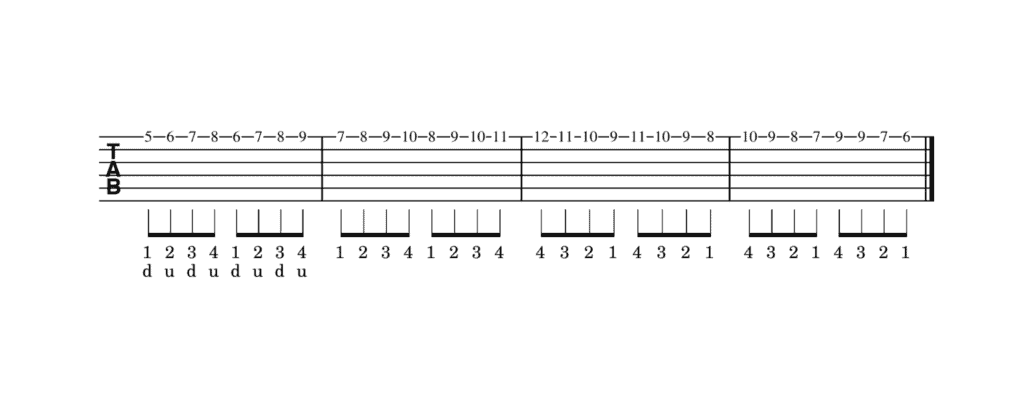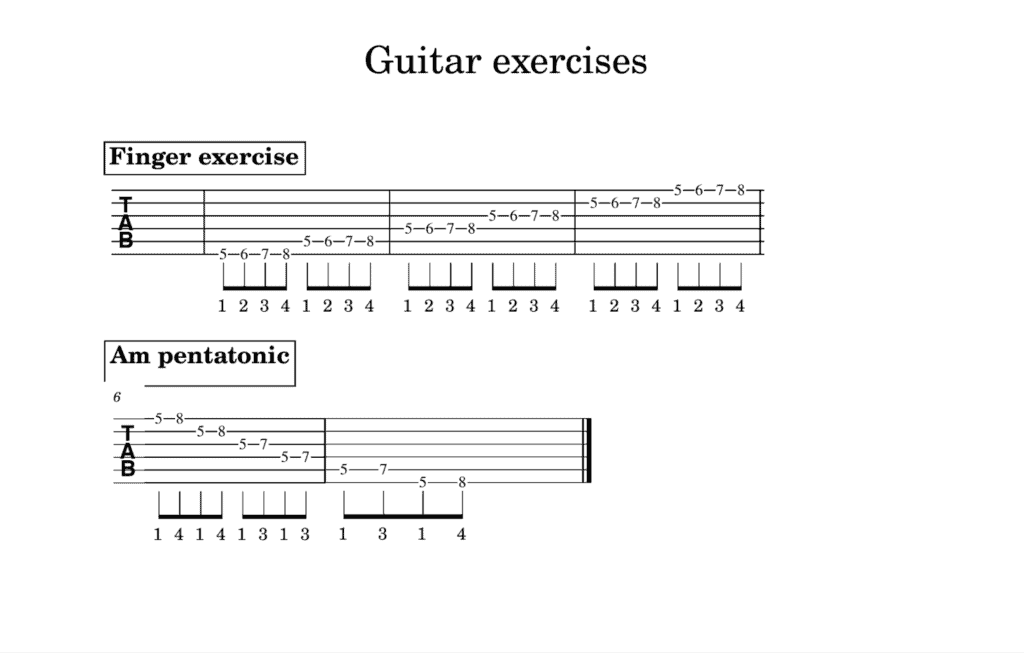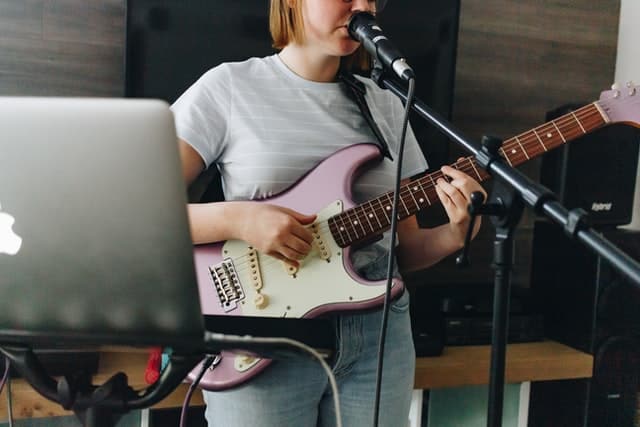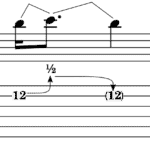For experienced guitar players, tabs are a great help when learning a song, and finger position usually comes naturally at that point. If you’re a beginner, however, it can be a little daunting, especially if you’re not familiar with economic hand movement.
Most of the time, your index finger will play the lowest number and then you’ll ascend up your fingers as the fret numbers increase. For example, if you’re playing the 2nd, 3rd, 4th, and 5th fret, you’ll play the second with your index, the third with your middle finger, and so on.
It’s not always that straight forward though and most of the time your hand position changes a lot, or what if the tab dictates a chord you’re unfamiliar with? Well, read on to find out the best method for figuring out finger positioning.
Do guitar tabs indicate which fingers to use?
In most cases, they don’t. However, some guitar books take the time to put in finger numbering, especially in technical exercises.
In this case, the numbers 1-4 are used to indicate the fingers (starting at the index finger) to use for each fret and they follow above the TAB bars over each fret value.

There are other forms of notation and assistance that can be found on tabs, such as chord diagrams to show how each noted chord should be played, along with symbols for ghost notes, slides, bends, and so forth.
How to know what fingers to use when reading guitar tabs?
In the case that your tab doesn’t have the numbering above to show you which fingers to use, your best choice is to think of positions when you play.
A position is a string of consecutive notes that are closely laid next to each other, for example, 4,5,6,7, or 8, 9, 10, 11. The first fret in a set of four marks the beginning of the position which is played with the index finger.
As long as you practice finger exercises and scale positions as well as good finger movement and economy, you’ll get the hang of it very easily. If it’s your first time sitting with your guitar though, then you’re unlikely to make it easy for yourself, there are some things to remember:
- Try to use all four of your fingers for the frets that are right next to each other, it may be hard at first, but it’s a lot more efficient than using your index finger to play three consecutive notes on three different frets
- When moving your hand up or down the neck, it’s easier to use your index finger as a root for switching positions. Say you’re jumping from 5 to 11, it’s fine to play both with your index if the notes following aren’t quick descending notes.
- Everything takes time and much of how you fret the notes is contextual to the song, the bottom line is comfort and good technique.

Is there a correct fingering for every tab?
I don’t think so. There are common practices that may mean you’ll play a lot of tabs very similarly, but some players have different approaches.
I won’t say there is one way to play every tab, but I will say there are many ways to play tabs inefficiently. Favoring one finger over others is just one, but there are a few others worth mentioning:
Not using your pinky:
Your pinky tends to cling dependently to your ring finger when you’re first starting out playing and most beginners avoid using their pinky for as long as they can. This is bad because a lot of songs are made around using all four fingers and so you’ll just have a hard time playing them with three.
Not learning scale shapes:
A great way to improve your ability to read tabs is to learn scale shapes. All songs are based around patterns on scales and while some may bend and break the shape here and there, most of the time, knowing a major scale will help you to recognize easier ways to play the notes.
Choosing songs that are too advanced for you:
I know when I got my first guitar I soon tried learning Creed’s One Last Breath, which is not really a beginner song, so I spent a long time playing that song incorrectly. Worse still, I carried bad habits that I’d developed trying to compensate for my lack of skill over into other songs.
Does fingering matter at all when playing guitar?
Yes! It makes a huge difference in how you play. There are a lot of finger exercises for this very reason. Good fingering is necessary for efficient playing and a good economy of movement.
The easiest way to improve your skill in this regard is to start by developing your finger independence.
There are a ton of exercises for this and a lot of good youtube videos to follow along to.
As a beginner, you’d usually start by just getting your fingers used to playing in sequence with each other, for example, playing first the index and then middle finger on any two given frets, then playing the index and middle finger, and so on.
I’ve provided a few finger exercises you could try out to demonstrate what I mean and hopefully save you some search time.
Aside from just finger independence, when it comes to learning songs, the fingering of each song is unique, and so it begs the question of how to go about learning new patterns each time.
In this case, you should work through the song in sections, but choose a song that you feel you could learn to completion. It’s often a waste of time to learn bits of songs because you rob yourself of the lesson learned about transitioning between sections and how songs are generally structured.
So as for learning it in sections, start with the first bar of the intro, get it right and then move to the second bar and move through systematically.
I find it helps to learn songs this way because usually, patterns repeat with slight differences, so if you can play one part well, it translates to the next section rather than playing everything, but badly.
Do different players use different fingerings when playing?
Yes, they do. Mostly it comes down to individual style and which techniques they learned and spent the most time on while learning.
Hand size also plays a part in how different guitar players play songs. Take John Mayer for example, he’s known for having huge hands and a lot of his songs take advantage of this.
Much like Jimi Hendrix, Mayer plays bass notes with his thumb, which is a pretty unique fingering style when compared to the overwhelming majority of players.
Musicians in different genres tend to have slightly different fingering styles. Blues guitar players and metal guitarists both play quite differently and it’s mainly due to their technique.
I wouldn’t go so far as to say that every player plays differently, I would say that most of us play very similarly and that’s not a bad thing. Good technique is good technique and that comes down to practice-based development.
Figuring Out Fingering
I hope we’ve covered enough of the details of how fingering in songs works, but just to recap:
- Develop finger independence
- Take it slow, don’t do songs too far above your skill level
- Learn different scales and become familiar with common shapes
- Think about positioning and economy of movement
- Develop your left hand
This should make finger positioning become a very natural thing for you.

Hello there, my name is Ramiro and I’ve been playing guitar for almost 20 years. I’m obsessed with everything gear-related and I thought it might be worth sharing it. From guitars, pedals, amps, and synths to studio gear and production tips, I hope you find what I post here useful, and I’ll try my best to keep it entertaining also.





